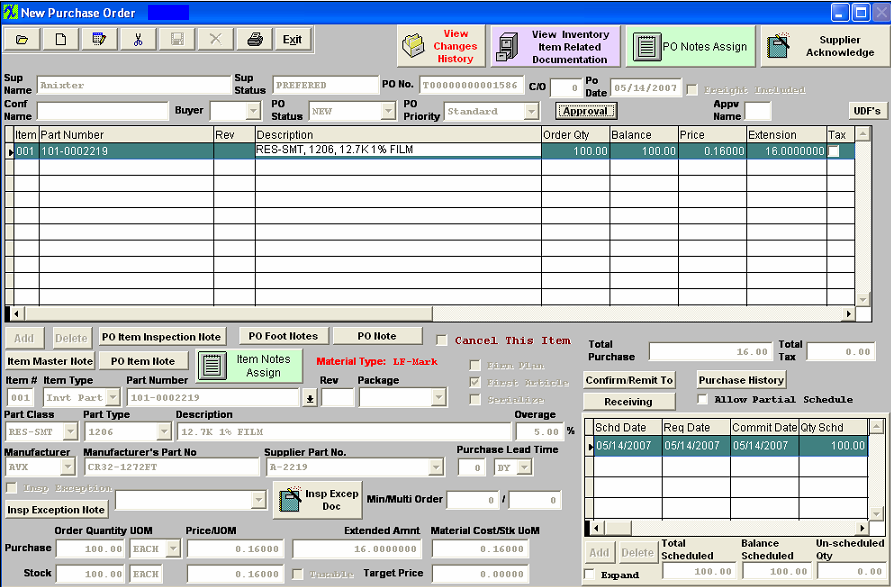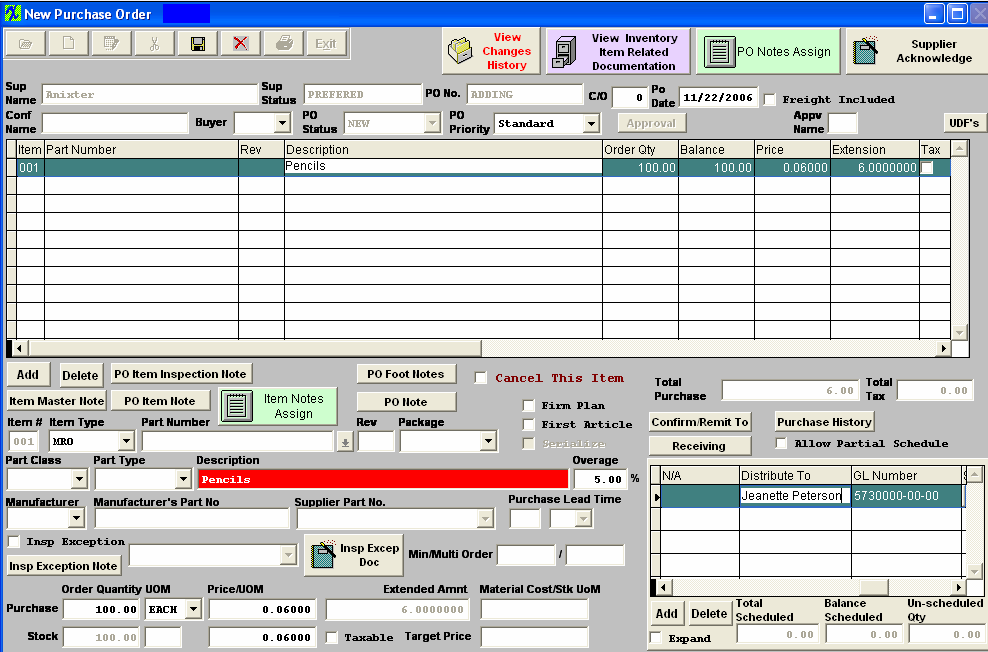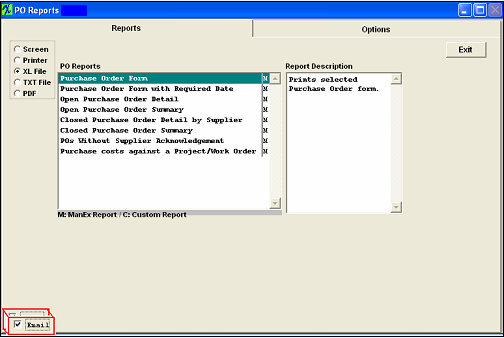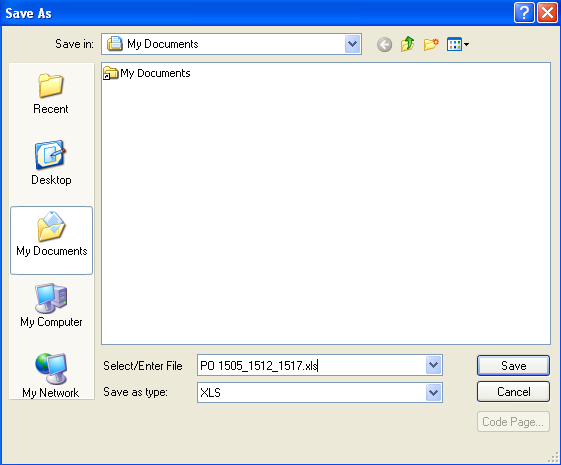| 1. How To ..... for PO Mgmt |
| 1.1. Find a Purchase Order | ||||||||||||||||
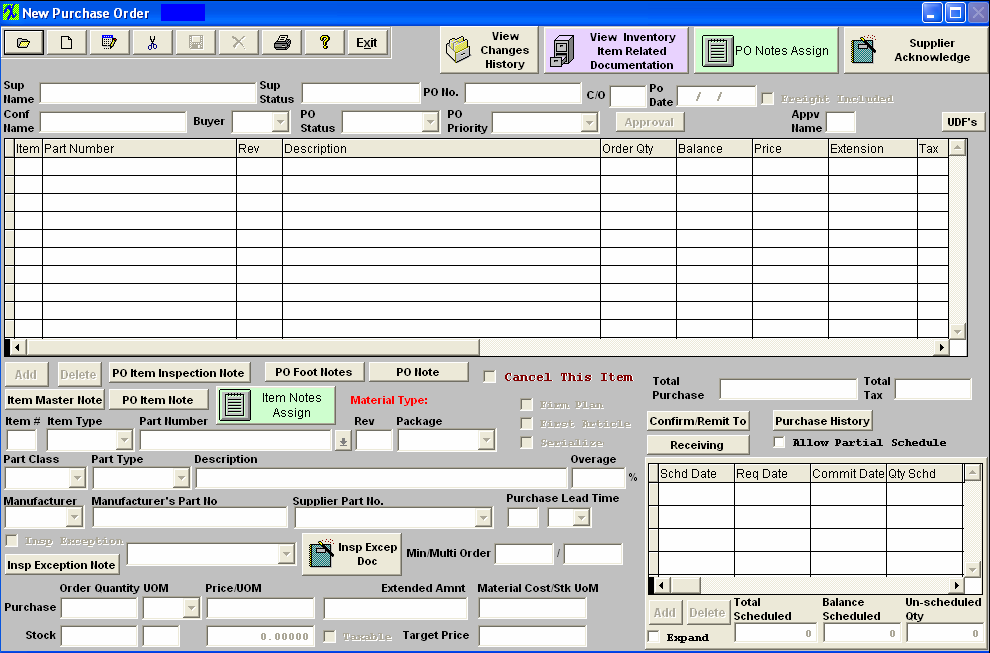
3. Once you’ve made your “search for” choice, determine the search method by choosing between PO Number, Inventory Part Number, MRO Part Number, Supplier, Inventory Manufacturer Part Number, MRO Manufacturer Part Number, All, Inventory Description, or MRO Description.
The rest of the right hand selections are essentially the same as for those illustrated above. 5. After finding the Purchase Order, the Purchase Order screen appears, populated with any parts on order.
|
| 1.2. Add A Purchase Order | ||||||||||||
The following screen will appear:

The user may enter the number or name in the red edit box above the Supplier or Supplier ID label, or scroll down to select a supplier. Double clicking on a supplier or pressing the ENTER key on a highlighted supplier selects the supplier and displays the Purchase Order screen with the supplier included. Once a supplier is identified, the remaining information fields become active. The user can CANCEL the action if needed. The user then may fill in the Confirm Name, Buyer and add items to the purchase order.
Entering Item Detail Information
|
| 1.2.1. Inventory Part | ||||||||||||||||||||||||||||||
Selecting Inventory Parts as the item type, the user may jump directly to the part number box (click on it) and enter a part number. Or, the user may step through the Part Classes and Part Types to narrow the focus and then select a part from the desired part type. Once a part number from Inventory has been entered, ManEx completes the boxes associated with the item master.
The user may edit or add a percentage amount of extra material that will be allowed to be shipped against the order. By entering a percentage in the OVERAGE field, receiving will be allowed to receive extra parts up to the limit imposed in this field. The user may also edit or add in purchasing lead time and min/mult order quantities through the Purchase Order Management module.Once the record has been saved this information will then be updated within the Inventory Control Management under the MRP Info screen. The user may check the box for Inspection Exception and select from the Inspection Exception Pulldown (which is established in the Inspection Exception Setup module). The user will then also be allowed to enter any Inspection Exception Notes and/or Load Insp Excep doc that pertain to that PO line item. This information will then be displayed within the PO Receiving as reference information to the users that are processing the Receipts through the system. The user is then prompted for the purchase order quantity of parts to be ordered. The user may enter either the Purchase Quantity or the Stocking Quantity, and ManEx will complete the other field based on the purchase/stocking unit of measure and conversion field.
NOTE: When creating a PO for an item with different purchasing and stocking UoMs, be sure to enter the MRP suggestion into the Stocking qty field rather than the purchasing qty field. The system will automatically convert the stocking unit into the purchasing unit for the purchase order qty.
For example if the buyer is creating a PO for an item that is used by inches but sold by the foot, the user would enter qty of 24 into the stocking qty field and the PO would automatically convert it to 2 feet in the purchasing qty field. So the supplier deals in feet, but ManEx deals in inches. The conversion between the two are established in the Unit of Measure & Conversion module.
Then the unit price is entered (Price Each). The extended amount is shown, calculated by extending the quantity by price. (If the inventory part that you are creating a line item for currently has a standard cost of 0.00 within inventory control the system will prompt the user if you wish to take that Purchase Order Price entered and use it as the standard cost for that item within inventory control). This can not be controlled by the Security level due to the fact that it is better practice to have a $$ assigned to the ICM record before the Purchase Order Receipt is accepted into the system. Otherwise you will have stock that is not valued properly, accounting records that will not be correct, etc. . . . So this is why ManEx allows any Purchase Order user to populate the STD cost field for that record with the purchase $ that you are loading. BUT . . Once a Std Cost is associated with the ICM record - the users within Purchase Order Management should no longer be able to change that value through the PO module. The user may then indicate that the items are taxable by clicking on the Taxable check box. The Stock/BOM field will update automatically based upon the conversion table defined in setup. The completed screen should appear as follows: Before saving the order you will need to check the expand box and enter the Schedule detail information.
There are situations when the users will either not enter a schedule or enter a partial schedule at time of creating PO. If the scheduled qty does not match the order qty or the "Allow Partial Schedule" box is unchecked, upon depressing the Save button the following message will be displayed. This gives the user the option to stop the save process and return to the item and schedule or continue on and save without scheduling. Some users may not know an exact date for scheduling at the time of the PO creation and just create the PO to get the part on order. Then upon the supplier response add the scheduled dates to the PO at a later time. This is why we do not enforce the scheduling at the time of the PO creation.
 If the "Allow Partial Schedule" box is checked upon saving the PO without a schedule or a partial schedule this message will not be displayed.
Entering Schedule Detail Information
The item will schedule automatically by adding the lead time to todays date and schedule the entire order amount. (Note: MRP will NOT acknowledge qty's that are not scheduled).
 At this time the user has the option to change the Schd date/Req date/commit date information and also the Qty Schd.
Note: If user is not following MRP suggestions when creating POs they need to keep in mind inspection time when entering a schedule for a PO.
If the user wants to modify the automatic scheduled date, they can either manually adjust the Date information by highlighting the field and typing in the new date, or place the cursor in the Due Date field.Type in a ?. A calendar will appear. Depress the desired delivery date.To advance into the next month, depress the > button. Schedule Field Definitions
Pressing the Save button at the top of the screen saves the order and item(s) entered, and assigns a temporary number to the order. After adding items to the purchase order and saving them, the Purchase Order will display all items added to the order.
The user may use the scroll bars at the right and bottom of the items listed to scroll over additional information. The user may modify the column widths in the current view by placing the cursor on the right border of the column in the column header, and pressing the left mouse button. Moving the border while holding the mouse button then releasing at the new location resizes the columns.
|
| 1.2.1.1. Allocate to Special Work Order or Project |
Introduction Inventory Allocation is used to allocate (reserve) quantities of existing items in stock or future Purchase Order deliveries to a Work Order or Project Number.This allocation prevents issuing the quantity reserved to any other use except the Work Order or Project Number specified. Purchase Order Line Item allocations may be removed prior to receipt of the parts by editing the Purchase Order.After receipt of parts allocated by Purchase Order, the allocation may only be removed after the parts are in stock, by using the Inventory Allocation module. ALLOCATION OF PURCHASE ORDER DELIVERIES Allocating a PO Line Item is used to make sure that the item will be reserved for a particular Work Order or Project Number when it is received.PO line item allocation is generally used when allocating to a Work Order or Project Number for which the items are not available in stock.Line Shortages of items not on the BOM, which are not in stock, are an example of typical PO Line Item Allocations.To allocate Purchase Order Line Item Deliveries to a Work Order or Project Number:
PROCEDURES To Allocate a PO Line Item to a Work Order or Project Number:
To Un-allocate a PO Line Item that has not yet been Dock Received:
To Un-allocate a PO Line Item that has already been Dock Received:
|
| 1.2.2. MRO Items |
MRO stands for Maintenance, Repair and Operations. Generally this is used for supplies, etc. purchases. After selecting the Item Type to be "MRO" If the MRO item is included in inventory
a. The user may jump directly to the part number box (click on it) and enter a part number. Or, the user may step through the Part Classes and Part Types to narrow the focus and then select a part from the desired part type. b. Fill in the quantity and unit price. If the MRO item is NOT included in inventory a. The user may enter in the Suppliers part number manually (or leave blank) and then jump to the description field and enter the description.
The finished screen should look like the screen displayed:
The completed Schedule screen will appear as follows:
|
| 1.2.3. Service Items |
Service items are for those instances where the assembly is outsourced. After selecting the Item Type to be "Service"
The finished screen should look like the screen displayed:
The completed Schedule screen will appear as follows:
|
| 1.3. Edit, Cancel, or Close a Purchase Order |
Find the Purchase Order that you would like to edit. Pressing the Edit record action button in the Purchase Order screen will allow the user to modify all the following information:
Depress the Save record action button after you have finished with editing the record. The user will then need to approve the order. If user has the "Auto Assign new Change Order # Upon Approval" box checked within the Purchase Setup module, the reminder will NOT be issued and CO# field becomes NOT editable. When the user approves the change the Change Order number will be automatically increased. If user has the "Auto Assign New Change Order # Upon Approval" box unchecked within the Purchase Setup module when user makes changes the CO# will stay the same, the system will prompt the reminder, and user may manually assign a change order number if applicable. There are situations when an item may not have a schedule or may have a partial schedule. If the "Allow Partial Schedule" box is checked within the Purchase Setup module, the system will NOT ask any questions when saving a po with only partial schedule. (Note: MRP will NOT acknowledge qty's that are not scheduled). If the "Allow Partial Schedule" box is unchecked within the Purchase Setup module, user will receive the following popup warning when editing and saving that line item or any other line item on that same purchase order:
 NOTE: If the "Auto Assign new Change Order # Upon Approval" box is checked, and PO is new and the user goes into the "Edit" mode prior to approval, no changes will be made to the CO# on screen or in the "View Changes History" screen. If PO has been approved and the user goes into the "Edit" mode the next CO# will be referenced in the "View Changes History" screen but will NOT increase on screen until PO has been approved. If the user goes to the "Edit" mode more than once before approving the change the CO# will only increase once in the "View Changes History" screen. NOTE: If users enter a PO number manually using a "T", then changes the numbering to Auto, and later edits and approves this PO the "T" will be changed to "0". The system has no way of knowing that the PO was manual numbered before the change. If multiple users are editing the same PO and the PO has not been approved yet, so it still has a temp # and the 1st users approves the PO, while the 2nd user is still making their changes, when the 2nd user goes to exit and save their changes they will receive the following message:  Manex tracks all revisions of a Purchase Order and each receipt against each revision of the order. The system will NOT allow any changes to a Purchase Order which has parts in Dock Receiving that have not yet been processed in the Purchase Order Receiving & Inspection module. Cancel a Purchase Order Find the Purchase Order you want to cancel. Press the Edit record action button in the Purchase Order screen this will allow the user to change the PO status from Open to Cancel. Note: User MUST have approval rights to Modify the PO Status.
Closing out a Purchase Order At times, the user may wish to close out a In the above set of circumstances, the user will be allowed to change the ORIGINAL order quantity by removing the rejected quantity via the DMR procedure. When the Received quantity PLUS the DMR quantity is LESS than the order quantity, the user will be allowed to decrease the order quantity by that many. Original Order 100; Received quantity 100; Rejected quantity 5. Returned to supplier via DMR 5. At this point, the user may reduce the quantity ordered, AND the accompanying amount scheduled to 95. This action will close out the Purchase Order. The user must depress the Edit button. Change the Purchase Order Quantity, then change the Quantity Scheduled so that the total of the schedule dates exactly equals the new quantity. Depress the Save button. Approve the PO and the
|
| 1.4. E-mail Purchase Order(s) | ||
To e-mail a Purchase Order report(s), depress the Reports button.
Note: You MUST have the e-mail setup within the Trigger.exe setup and working before the PO e-mail will work.
The reports screen will appear:
Complete the Option tab with the information required: Note: User has the option to check the Email box on the Options screen also.
Depress OK. The following screen will appear. Select or Enter File Name.
Depress Save, the following Check Email Addresses screen will appear. Within this screen you can enter an e-mail address or add any special notes needed:
Depress OK and documents will be sent to e-mail addresses assigned. The following is what the receiver will receive:
|
| 1.5. Approve a Purchase Order | ||||
The following screen will appear:  Approve PO Pressing the Approval button in the Purchase Order module will ask for the user’s password. The user must enter a password that has been authorized (within the Purchase Setup module) to approve the dollar amount of the order.
Entry of an authorized password and approval will inactivate the 1st approval button and place the initials of the person approving the order next to the approval button , (If in the Purchase Setup , the company has selected to allow one approval of purchase orders). Then upon approval the temporary Purchase Order number will be replaced with a permanent PO number (replacing the "T" with a "0").
If in the Purchase Setup , the company has selected requiring two approvals, then the process must be repeated for the second approval, and the temporary Purchase Order number will be replaced with a permanent PO number (replacing the "T" with a "0") once both approval are granted. Note: That if the Purchase Order is an Service or In-store order, once the
If the user has elected to use manual purchase order number,the screen will prompt the user for an order number to be applied to the purchase order. Note: If users enter a PO number manually using a "T", then changes the numbering to Auto, and later edits and approves this PO the "T" will be changed to "0". The system has no way of knowing that the PO was manual numbered before the change.
|
| 1.5.1. Inventory Part | ||||||||||||||||||||||||||||||
Selecting Inventory Parts as the item type, the user may jump directly to the part number box (click on it) and enter a part number. Or, the user may step through the Part Classes and Part Types to narrow the focus and then select a part from the desired part type. Once a part number from Inventory has been entered, Manex completes the boxes associated with the item master.
The user may edit or add a percentage amount of extra material that will be allowed to be shipped against the order. By entering a percentage in the OVERAGE field, receiving will be allowed to receive extra parts up to the limit imposed in this field. The user may also edit or add in purchasing lead time and min/mult order quantities through the Purchase Order Management module.Once the record has been saved this information will then be updated within the Inventory Control Management under the MRP Info screen. The user may check the box for Inspection Exception and select from the Inspection Exception Pulldown (which is established in the Inspection Exception Setup module).The user will then also be allowed to enter any Inspection Exception Notes and/or Load Insp Excep doc that pertain to that PO line item.This information will then be displayed within the PO Receiving as reference information to the users that are processing the Receipts through the system. The user is then prompted for the purchase order quantity of parts to be ordered. The user may enter either the Purchase Quantity or the Stocking quantity, and Manex will complete the other field based on the purchase/stocking unit of measure and conversion field. Then the unit price is entered (Price Each). The extended amount is shown, calculated by extending the quantity by price. (If the inventory part that you are creating a line item for currently has a standard cost of 0.00 within inventory control the system will prompt the user if you wish to take that Purchase Order Price entered and use it as the standard cost for that item within inventory control). This can not be controlled by the Security level due to the fact that it is better practice to have a $$ assigned to the ICM record before the Purchase Order Receipt is accepted into the system. Otherwise you will have stock that is not valued properly, accounting records that will not be correct, etc. . . . So this is why ManEx allows any Purchase Order user to populate the STD cost field for that record with the purchase $ that you are loading. BUT . . Once a Std Cost is associated with the ICM record - the users within Purchase Order Management should no longer be able to change that value through the PO module. The user may then indicate that the items are taxable by clicking on the Taxable check box. The Stock/BOM field will update automatically based upon the conversion table defined in setup. The completed screen should appear as follows: Before saving the order you will need to check the expand box and enter the Schedule detail information. Entering Schedule Detail Information
 At this time the user has the option to change the Schd date/Req date/commit date information and also the Qty Schd. Note: If user is not following MRP suggestions when creating POs they need to keep in mind inspection time when entering a schedule for a PO.
If the user wants to modify the automatic scheduled date, they can either manually adjust the Date information by highlighting the field and typing in the new date, or place the cursor in the Due Date field.Type in a ?. A calendar will appear. Depress the desired delivery date.To advance into the next month, depress the > button. Schedule Field Definitions
Pressing the Save button at the top of the screen saves the order and item(s) entered, and assigns a temporary number to the order. After adding items to the purchase order and saving them, the Purchase Order will display all items added to the order.
The user may use the scroll bars at the right and bottom of the items listed to scroll over additional information. The user may modify the column widths in the current view by placing the cursor on the right border of the column in the column header, and pressing the left mouse button. Moving the border while holding the mouse button then releasing at the new location resizes the columns. |
| 1.5.1.1. Allocate to Special Work Order or Project |
Introduction Inventory Allocation is used to allocate (reserve) quantities of existing items in stock or future Purchase Order deliveries to a Work Order or Project Number.This allocation prevents issuing the quantity reserved to any other use except the Work Order or Project Number specified. Purchase Order Line Item allocations may be removed prior to receipt of the parts by editing the Purchase Order.After receipt of parts allocated by Purchase Order, the allocation may only be removed after the parts are in stock, by using the Inventory Allocation module. ALLOCATION OF PURCHASE ORDER DELIVERIES Allocating a PO Line Item is used to make sure that the item will be reserved for a particular Work Order or Project Number when it is received.PO line item allocation is generally used when allocating to a Work Order or Project Number for which the items are not available in stock.Line Shortages of items not on the BOM, which are not in stock, are an example of typical PO Line Item Allocations.To allocate Purchase Order Line Item Deliveries to a Work Order or Project Number:
PROCEDURES To Allocate a PO Line Item to a Work Order or Project Number:
To Un-allocate a PO Line Item that has not yet been Dock Received:
To Un-allocate a PO Line Item that has already been Dock Received:
|
| 1.5.2. MRO Items |
MRO stands for Management Required Options. Generally this is used for supplies, etc. purchases. After selecting the Item Type to be "MRO"
The finished screen should look like the screen displayed:
The completed Schedule screen will appear as follows:
|
| 1.5.3. Service Items |
Services items are for those instances where the assembly is outsourced. After selecting the Item Type to be "Service"
The finished screen should look like the screen displayed:
The completed Schedule screen will appear as follows:
|
| 1.6. Load Supplier Acknowledgement |
How to attach or load a Supplier Acknowledge document to a PO. Note: User is only allowed to load one document per Purchase order.
 Depress the "Supplier Acknowledge" button and the following screen will appear:
 To load images or documents, depress the "Load Document" button, up in the right hand corner of the screen. A browser screen will appear similar to the one below: 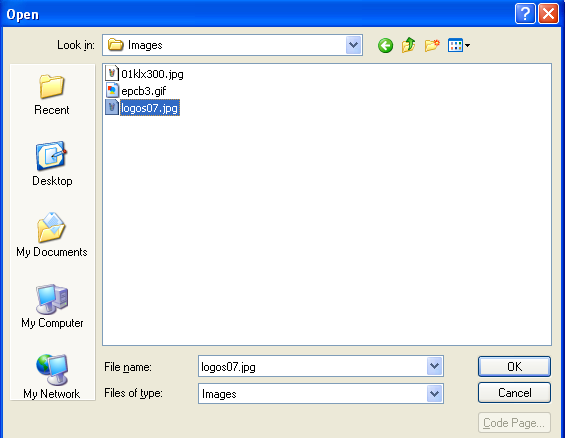 Find and highlight the desired Image file, as illustrated.
Once the file name appears, depress the Ok button. Note: that the user can also load other document types by changing the File of Type to ALL
The file will appear in the screen as displayed:  Depress the Save action button to save the changes or depress the Abandon changes action button to abandon changes. Exit will bring the user back to the Purchase Order Management module. If user selected to Save the Supplier Acknowledge button will be displayed in Red as shown below.
 |
| 1.7. Copy "View Change History" Notes |
Find the Purchase Order you want to Copy the "View Changes History" notes on.
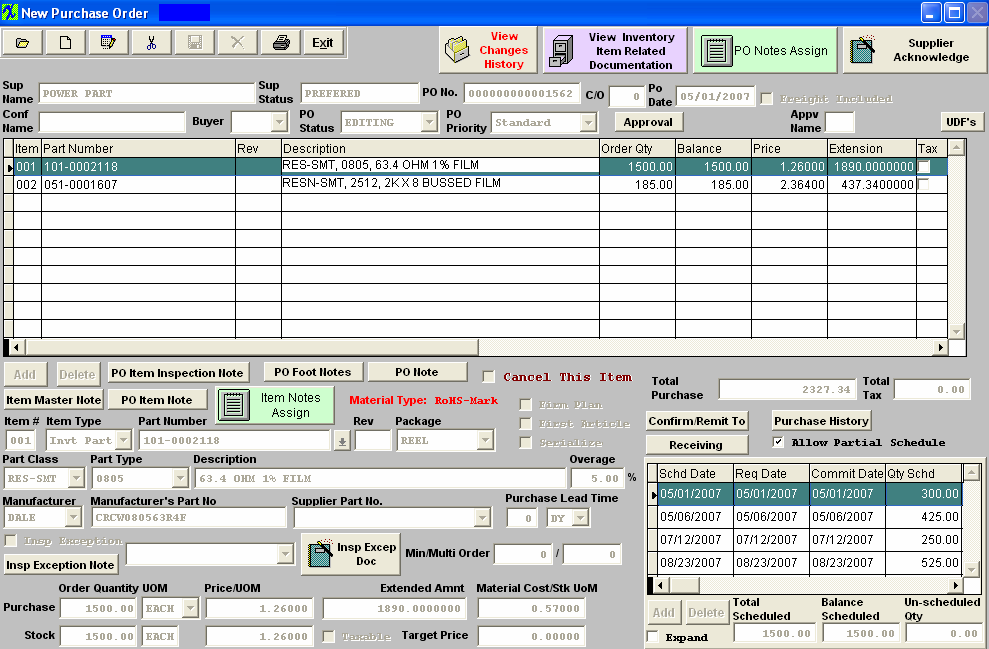 Depress the "View Changes History" button, When in the “Change PO history” screen, click on the vertical scroll (on your keyboard), you will see the cursor appeared on the top inside the window with the text.
 Depress the "CTRL" button + the vertical scroll buttons to highlight the information you wish to copy;
 Depress the "CTRL + C" to copy, then paste to a document, e-mail, etc....
 |



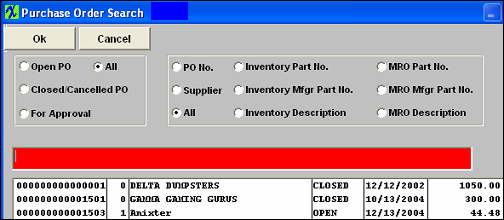
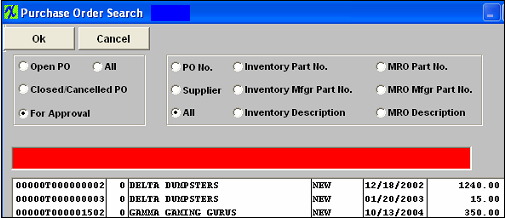

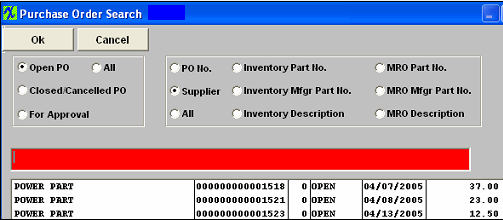
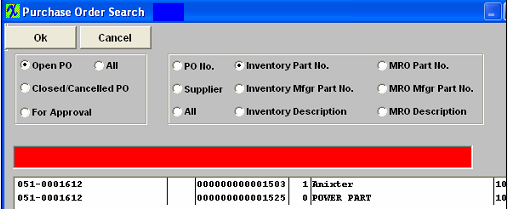
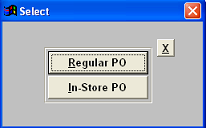
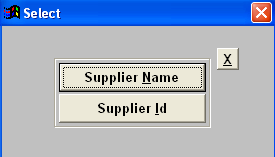
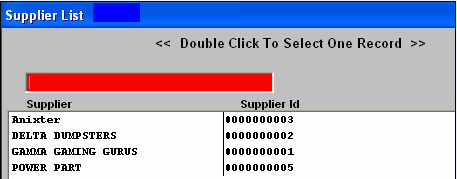
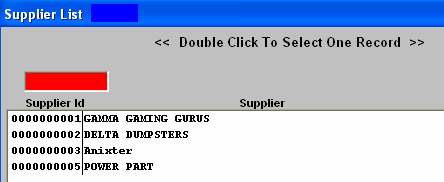
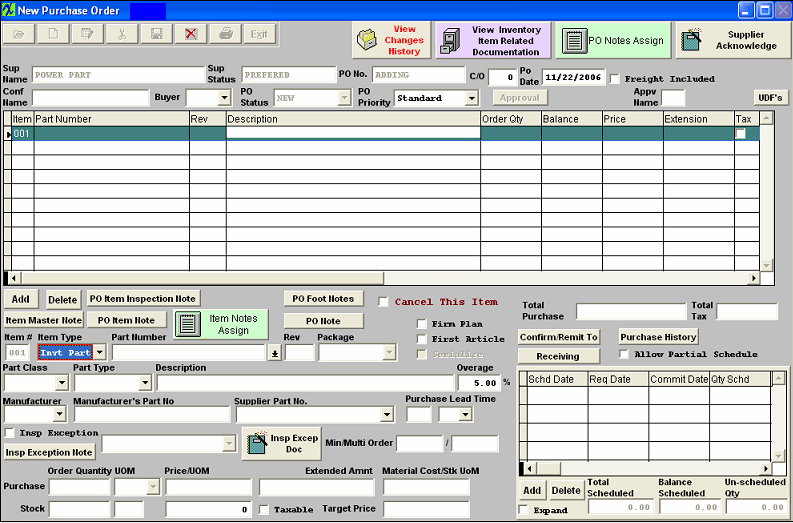

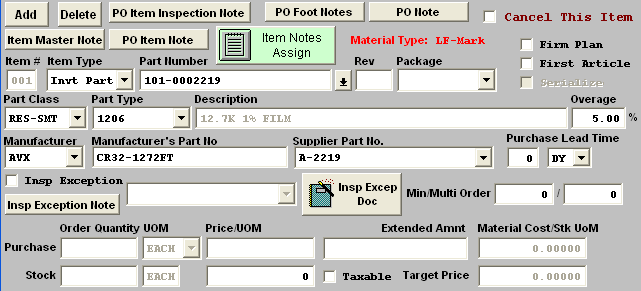


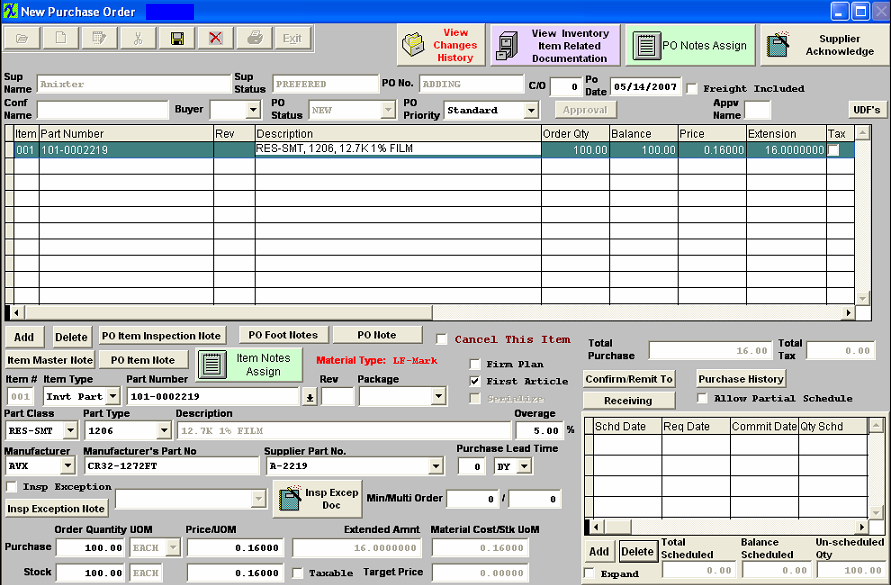

 button will bring up a screen where the user can enter in specific notes that pertain to that one schedule, item, and date. Type in the note. Depress the Save button. Exit
button will bring up a screen where the user can enter in specific notes that pertain to that one schedule, item, and date. Type in the note. Depress the Save button. Exit